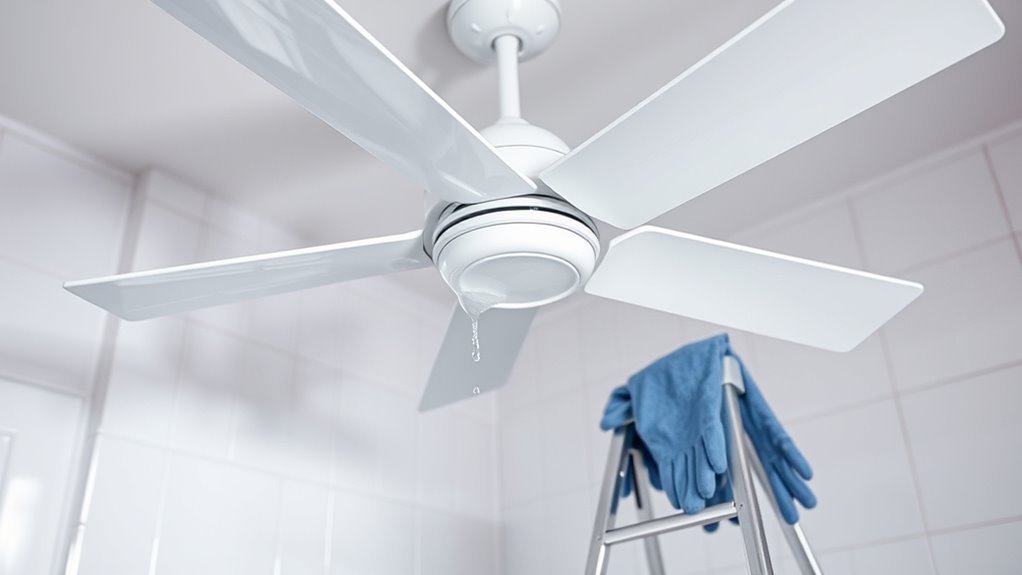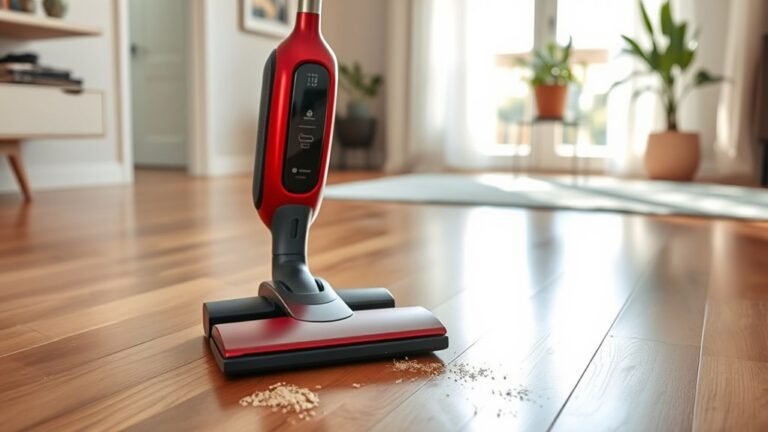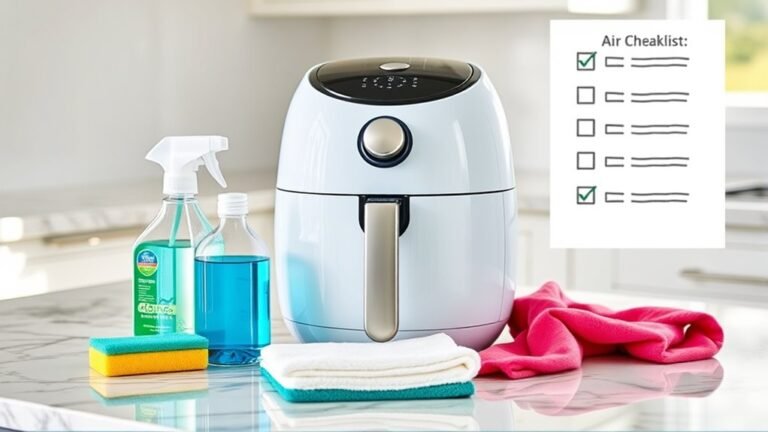How to Clean Bathroom Exhaust Fans Properly
To clean your bathroom exhaust fan properly, first turn off the power at the circuit breaker for safety. Use a screwdriver to remove the fan cover, then vacuum or wipe dust off the blades and cover with a microfiber cloth. Avoid spraying liquids on the motor. Check the vent for blockages and dry all parts thoroughly before reassembling. Doing this every few months keeps your fan efficient and prevents mold. Keep going to uncover helpful maintenance tips for lasting performance.
Tools and Materials Needed for Cleaning
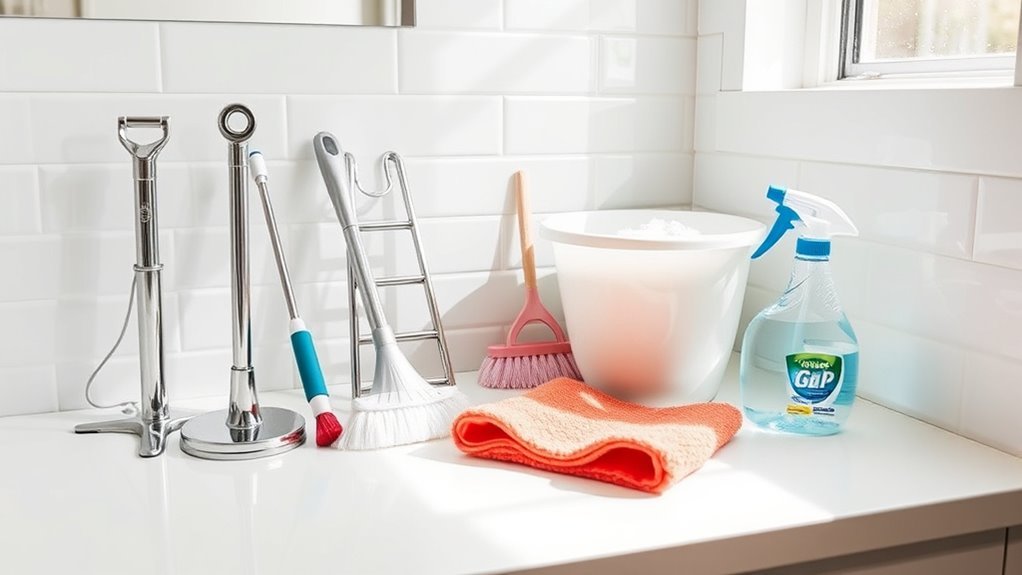
To effectively clean your bathroom exhaust fan, you’ll need a few essential tools and materials on hand. Start with basic cleaning supplies: a screwdriver to remove the fan cover, a vacuum with a brush attachment to clear dust, and a microfiber cloth for wiping down surfaces. You’ll also want a mild detergent or all-purpose cleaner to tackle grime. Having a step ladder or sturdy stool will help you reach the fan comfortably. To keep your freedom from constant worry about your bathroom’s air quality, establish a maintenance schedule—cleaning your exhaust fan every three to six months prevents buildup and guarantees efficiency. With these tools and a routine, you’ll enjoy a fresh, well-ventilated space without hassle or unexpected repairs.
How to Safely Turn Off Power to the Exhaust Fan
Before you start cleaning your bathroom exhaust fan, make certain the power is completely turned off to avoid any electrical hazards. First, locate the power source—usually your home’s circuit breaker panel. Flip the switch labeled for your bathroom or exhaust fan to cut off electricity. Double-check the fan isn’t running by turning it on briefly before you start.
| Step | Action | Tip |
|---|---|---|
| Locate panel | Find the circuit breaker box | Usually in basement or utility room |
| Identify breaker | Find breaker for bathroom fan | Label or test switches |
| Switch off | Flip the breaker to “Off” | Confirm power is off |
| Verify | Test fan switch | Ascertain no electricity flows |
Turning off the power gives you freedom to clean safely and confidently.
Removing the Exhaust Fan Cover
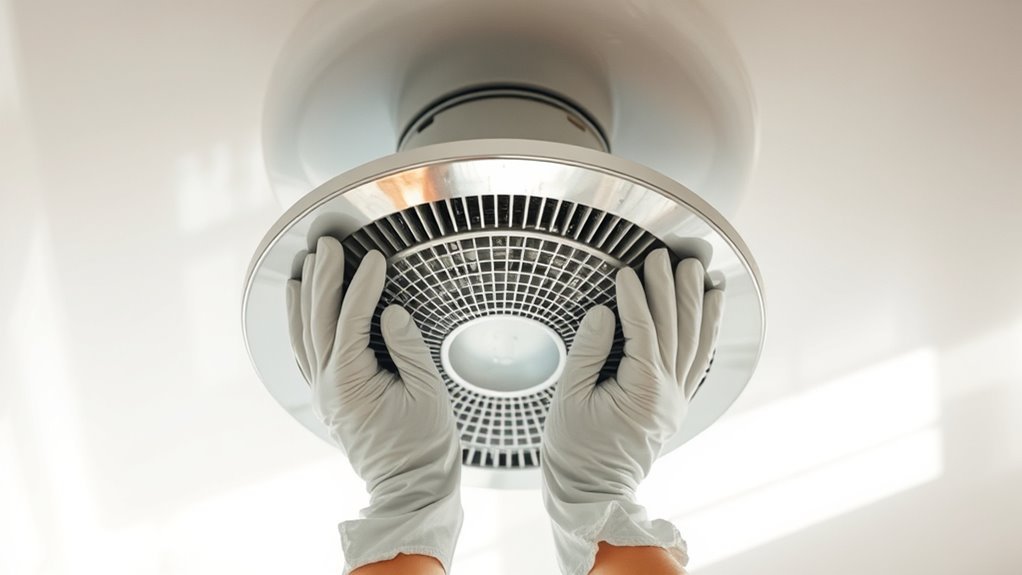
Before you start removing the exhaust fan cover, make sure you have the right tools like a screwdriver handy. Always double-check that the power is off to avoid any accidents. Taking these safety precautions will make the process smooth and secure.
Tools Needed
Although removing the exhaust fan cover might seem straightforward, having the right tools on hand will make the job much easier and safer. You’ll want a screwdriver—usually a Phillips or flathead—to gently loosen the screws holding the cover in place. A step ladder or sturdy stool helps you reach the fan without strain, giving you freedom to work comfortably. For the actual cleaning, keep your preferred cleaning solutions nearby to tackle dust and grime efficiently once the cover is off. Don’t forget basic maintenance tools like a soft brush or microfiber cloth to avoid damaging delicate components. By having these essentials ready, you’re not only speeding up the process but also ensuring your bathroom exhaust fan stays in good shape longer without hassle.
Safety Precautions
When you start removing the exhaust fan cover, make certain the power is completely off to avoid any electrical hazards. Unplug the fan or switch off the circuit breaker to guarantee electrical safety. Before you touch anything, wear personal protective gear like gloves and safety glasses to shield yourself from dust and sharp edges. Take your time loosening the clips or screws holding the cover—rushing can damage the fan or cause injury. If the cover is stuck, gently wiggle it instead of forcing it off. Staying cautious lets you enjoy the freedom of a clean, safe bathroom fan without risking harm. Prioritizing these safety precautions guarantees your cleaning process is smooth and accident-free.
Cleaning Dust and Debris From the Fan Blades
Cleaning dust and debris from the fan blades is an essential step to guarantee your bathroom exhaust fan runs efficiently. For effective fan blade maintenance, start by carefully removing the fan cover to access the blades. Use a soft brush or a microfiber cloth to gently wipe away accumulated dust—this dust removal prevents the motor from overworking, saving energy and extending your fan’s lifespan. Be thorough but gentle to avoid bending the blades. Avoid spraying liquids directly on the motor; instead, lightly dampen your cloth if needed. Regular dust removal keeps your exhaust fan running smoothly and quietly, giving you the freedom to enjoy a fresher bathroom environment without hassle. Staying on top of this simple task means better air circulation and less buildup down the line.
Washing and Drying the Fan Cover
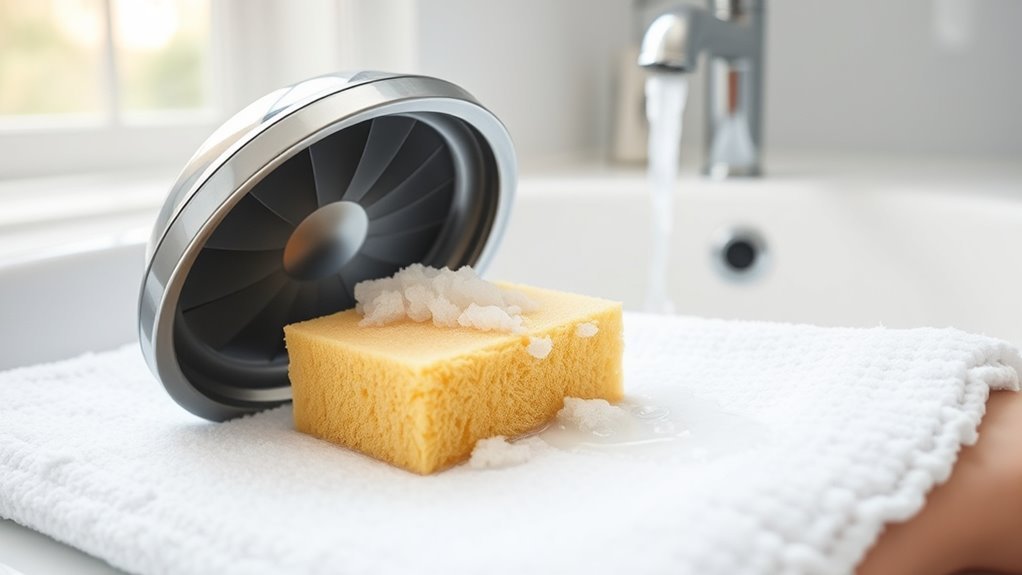
After dusting the fan blades, the next step is to give the fan cover a proper wash. You want to restore its shine and remove any lingering grime using effective cleaning solutions. Here’s how to do it right:
- Fill a basin with warm water mixed with a mild cleaning solution.
- Submerge the fan cover and let it soak for 10–15 minutes.
- Gently scrub with a soft brush or cloth to lift away dirt and buildup.
- Rinse thoroughly with clean water to remove any soap residue.
Once clean, shake off excess water and set the fan cover on a towel in a well-ventilated area. Let it air dry completely before reattaching. This simple step guarantees your bathroom exhaust fan cover looks fresh and helps maintain its efficiency.
Inspecting the Fan Motor and Vent Duct
Now that the fan cover is clean, you’ll want to check the motor for any signs of wear or damage. Make certain the fan spins freely without any unusual noises or resistance. Don’t forget to inspect and clean the vent duct to guarantee proper airflow and prevent buildup.
Motor Condition Check
Before you immerse yourself in cleaning, it’s important to check the condition of the fan motor and vent duct to verify everything is functioning properly. The fan motor’s performance directly affects your bathroom’s air quality and energy efficiency. Start by listening for unusual noises or vibrations that signal wear. Next, ascertain the motor spins freely; stiffness may indicate it needs lubrication. Use proper lubrication techniques to keep it running smoothly without over-oiling. Also, inspect wiring for frays or damage to avoid electrical hazards. Here’s what to focus on:
- Listen for grinding or rattling sounds
- Check motor shaft for smooth rotation
- Apply appropriate lubrication sparingly
- Examine electrical connections for safety
Taking these steps empowers you to maintain your fan’s freedom to operate efficiently.
Vent Duct Cleaning
While inspecting the fan motor is essential, you shouldn’t overlook cleaning the vent duct, as buildup inside can reduce airflow and cause odors. To maintain your bathroom’s ventilation efficiency, regular duct inspections are key. Grab a flashlight and check for dust, debris, or mold obstructing the duct. If you spot any blockages, use a long brush or vacuum attachment to clear them out. Keeping the duct clean not only improves air circulation but also prevents moisture buildup that invites mold growth. Don’t let neglect limit your freedom to breathe fresh air—take control by scheduling duct inspections every few months. This simple step guarantees your exhaust fan works at peak performance, keeping your bathroom fresh and your home healthier.
Reassembling the Exhaust Fan Components
Once you’ve thoroughly cleaned each part, you can begin reassembling the exhaust fan components by carefully aligning the motor, blades, and housing. Take your time to verify everything fits perfectly, so your fan runs smoothly and quietly. Here’s how to proceed:
- Position the motor securely within the housing.
- Attach the fan blades firmly to the motor shaft.
- Align the housing back into its mounting bracket.
- Finish by securing the fan cover, making sure it snaps or screws in place tightly.
Reassembling components this way guarantees your bathroom exhaust fan is ready to perform efficiently. By paying attention to these details, you maintain your freedom from annoying noises and poor ventilation, keeping your space fresh and comfortable.
Tips for Regular Maintenance and Preventing Build-Up
To keep your bathroom exhaust fan working efficiently, you’ll want to perform regular maintenance and prevent dust and grime from building up. Start by setting a cleaning schedule that fits your lifestyle—every three to six months is ideal. Use regular inspections to spot any signs of dirt accumulation or unusual noise early on. This proactive approach helps avoid clogs and keeps airflow unrestricted, giving you freedom from costly repairs. Don’t forget to clean the fan blades and vent cover thoroughly each time. Keeping your fan clean not only extends its lifespan but also guarantees your bathroom stays fresh and mold-free. By committing to these simple steps, you maintain control over your space and enjoy the benefits of a smoothly running exhaust fan without hassle.
Frequently Asked Questions
How Often Should Bathroom Exhaust Fans Be Replaced?
Did you know the average fan lifespan is about 10 to 15 years? If you want to keep your bathroom fresh and free from mold, you’ll want to watch for replacement signs like unusual noises, reduced airflow, or excessive dust buildup. Don’t wait for your fan to quit working—replacing it timely gives you the freedom to enjoy a healthier home environment without hassle or worry. Keep an eye out and act when needed!
Can Mold Grow Inside the Exhaust Fan?
Yes, mold can definitely grow inside your bathroom exhaust fan if moisture lingers. To keep mold at bay, regular fan maintenance is key—you’ll want to clean the fan blades and housing every few months. This not only helps with mold prevention but also keeps your fan running smoothly, giving you the freedom to enjoy a fresh, dry bathroom without worrying about hidden mold growth.
Are All Exhaust Fans Energy-Efficient?
Imagine your bathroom fan humming quietly, like a gentle breeze freeing stale air. Not all exhaust fans are energy-efficient; their energy ratings vary widely depending on fan types. Some models boast high-efficiency motors and smart designs that use less power, while others might drain more energy than necessary. If you want freedom from high bills and waste, look for fans with good energy ratings and features that match your lifestyle and environmental goals.
What Noise Level Is Normal for an Exhaust Fan?
When it comes to fan noise, a gentle hum or low whir is typical during normal operation. You shouldn’t hear loud rattling or buzzing—that usually means something’s off. If your exhaust fan sounds louder than a whisper, it might be clogged or need maintenance. You deserve a peaceful space, so keeping your fan running smoothly guarantees it quietly does its job without disrupting your freedom to relax.
Can Exhaust Fans Be Connected to Smart Home Systems?
You might think connecting your bathroom exhaust fan to your smart home system is like launching a rocket, but it’s actually pretty straightforward! With the right exhaust fan compatibility, you can enjoy seamless smart home integration, controlling ventilation with a simple voice command or app tap. This gives you total freedom to manage airflow without leaving your comfy spot, making your bathroom experience smarter and more convenient than ever before.
